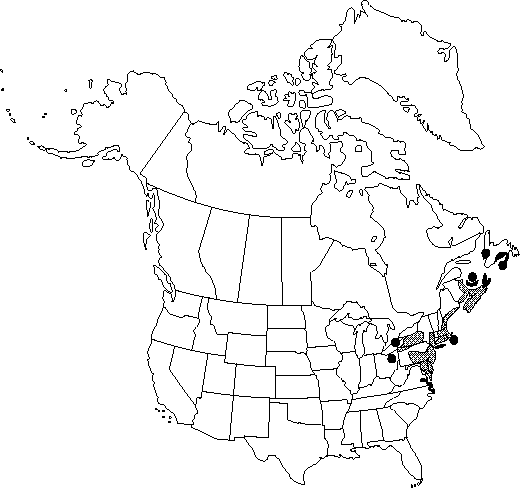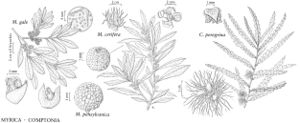Difference between revisions of "Myrica pensylvanica"
in H. Duhamel du Monceau et al., Traité Arbr. Arbust. Nouv. ed. 2: 190. 1804.
FNA>Volume Importer |
imported>Volume Importer |
||
| (7 intermediate revisions by 2 users not shown) | |||
| Line 1: | Line 1: | ||
{{Treatment/ID | {{Treatment/ID | ||
|accepted_name=Myrica pensylvanica | |accepted_name=Myrica pensylvanica | ||
| − | |accepted_authority=Mirbel | + | |accepted_authority=Mirbel |
|publications={{Treatment/Publication | |publications={{Treatment/Publication | ||
|title=in H. Duhamel du Monceau et al., Traité Arbr. Arbust. Nouv. ed. | |title=in H. Duhamel du Monceau et al., Traité Arbr. Arbust. Nouv. ed. | ||
| Line 13: | Line 13: | ||
}}{{Treatment/ID/Special_status | }}{{Treatment/ID/Special_status | ||
|code=F | |code=F | ||
| − | |label= | + | |label=Illustrated |
}}{{Treatment/ID/Special_status | }}{{Treatment/ID/Special_status | ||
|code=W | |code=W | ||
| Line 20: | Line 20: | ||
|basionyms= | |basionyms= | ||
|synonyms={{Treatment/ID/Synonym | |synonyms={{Treatment/ID/Synonym | ||
| − | |name= | + | |name=Cerothamnus pensylvanica |
|authority=(Mirbel) Moldenke | |authority=(Mirbel) Moldenke | ||
| − | }}{{Treatment/ID/Synonym | + | |rank=species |
| − | |name= | + | }} {{Treatment/ID/Synonym |
| + | |name=Myrica cerifera var. frutescens | ||
|authority=Castiglioni | |authority=Castiglioni | ||
| − | }}{{Treatment/ID/Synonym | + | |rank=variety |
| − | |name= | + | }} {{Treatment/ID/Synonym |
| + | |name=Myrica macfarlanei | ||
|authority=Youngken | |authority=Youngken | ||
| + | |rank=species | ||
}} | }} | ||
|hierarchy=Myricaceae;Myrica;Myrica pensylvanica | |hierarchy=Myricaceae;Myrica;Myrica pensylvanica | ||
| Line 36: | Line 39: | ||
}}<!-- | }}<!-- | ||
| − | --><span class="statement" id="st- | + | --><span class="statement" id="st-undefined" data-properties=""><b>Shrubs </b>or rarely small trees, deciduous, rhizomatous, colonial, to 2(-4.5) m. <b>Branchlets</b> reddish brown and gland-dotted when young, becoming whitish gray in age, otherwise densely pilose; glands yellow. <b>Leaf</b> blade aromatic when crushed, oblanceolate to elliptic, occasionally obovate, 2.5-6.5(-7.8) × 1.5-2.7 cm, usually membranous, less often leathery, base cuneate to attenuate, margins sometimes entire, usually serrate distal to middle, apex obtuse to rounded, sometimes acute, short-apiculate; surfaces abaxially pale green, pilose on veins, moderately to densely glandular, adaxially dark green, pilose (especially along midrib), glandless or sparsely glandular; glands yellow-brown. <b>Inflorescences</b>: staminate 0.4-1.8 cm; pistillate 0.3-1.4 cm. <b>Flowers</b> unisexual, staminate and pistillate on different plants. <b>Staminate</b> flowers: bract of flower shorter than staminal column, margins opaque, apically ciliate or completely glabrous, usually abaxially glabrous, occasionally densely pilose; stamens mostly 3-4. <b>Pistillate</b> flowers: bracteoles persistent in fruit, 4, not accrescent or adnate to fruit wall, margins slightly ciliate or glabrous, abaxially usually densely gland-dotted; ovary wall densely hirsute near apex, otherwise glabrous. <b>Fruits</b> globose-ellipsoid, 3.5-5.5 mm; fruit wall and warty protuberances hirsute, at least when young, hairs usually obscured by thick coat of white wax.</span><!-- |
-->{{Treatment/Body | -->{{Treatment/Body | ||
| Line 42: | Line 45: | ||
|habitat=Coastal dunes, pine barrens, pine-oak forests, old fields, bogs, edges of streams, ponds, and swamps | |habitat=Coastal dunes, pine barrens, pine-oak forests, old fields, bogs, edges of streams, ponds, and swamps | ||
|elevation=0-325 m | |elevation=0-325 m | ||
| − | |distribution=St. Pierre and Miquelon;N.B.;Nfld.;N.S.;Ont.;P.E.I.;Que.;Conn.;Del.;Maine;Md.;Mass.;N.H.;N.J.;N.Y.;N.C.;Ohio;Pa.;R.I.;Va. | + | |distribution=St. Pierre and Miquelon;N.B.;Nfld. and Labr. (Nfld.);N.S.;Ont.;P.E.I.;Que.;Conn.;Del.;Maine;Md.;Mass.;N.H.;N.J.;N.Y.;N.C.;Ohio;Pa.;R.I.;Va. |
| − | |discussion=<p>Where their ranges overlap, Myrica pensylvanica hybridizes quite readily with both M. cerifera and M. heterophylla. This ease of hybridization obviously contributes to an already complicated taxonomic situation; it is a matter for further field-based investigation.</p> | + | |discussion=<p>Where their ranges overlap, <i>Myrica pensylvanica</i> hybridizes quite readily with both <i>M. cerifera</i> and <i>M. heterophylla</i>. This ease of hybridization obviously contributes to an already complicated taxonomic situation; it is a matter for further field-based investigation.</p> |
|tables= | |tables= | ||
|references= | |references= | ||
| Line 52: | Line 55: | ||
-->{{#Taxon: | -->{{#Taxon: | ||
name=Myrica pensylvanica | name=Myrica pensylvanica | ||
| − | + | |authority=Mirbel | |
| − | |authority=Mirbel | ||
|rank=species | |rank=species | ||
|parent rank=genus | |parent rank=genus | ||
| − | |synonyms= | + | |synonyms=Cerothamnus pensylvanica;Myrica cerifera var. frutescens;Myrica macfarlanei |
|basionyms= | |basionyms= | ||
|family=Myricaceae | |family=Myricaceae | ||
| Line 62: | Line 64: | ||
|habitat=Coastal dunes, pine barrens, pine-oak forests, old fields, bogs, edges of streams, ponds, and swamps | |habitat=Coastal dunes, pine barrens, pine-oak forests, old fields, bogs, edges of streams, ponds, and swamps | ||
|elevation=0-325 m | |elevation=0-325 m | ||
| − | |distribution=St. Pierre and Miquelon;N.B.;Nfld.;N.S.;Ont.;P.E.I.;Que.;Conn.;Del.;Maine;Md.;Mass.;N.H.;N.J.;N.Y.;N.C.;Ohio;Pa.;R.I.;Va. | + | |distribution=St. Pierre and Miquelon;N.B.;Nfld. and Labr. (Nfld.);N.S.;Ont.;P.E.I.;Que.;Conn.;Del.;Maine;Md.;Mass.;N.H.;N.J.;N.Y.;N.C.;Ohio;Pa.;R.I.;Va. |
|reference=None | |reference=None | ||
|publication title=in H. Duhamel du Monceau et al., Traité Arbr. Arbust. Nouv. ed. | |publication title=in H. Duhamel du Monceau et al., Traité Arbr. Arbust. Nouv. ed. | ||
|publication year=1804 | |publication year=1804 | ||
| − | |special status=Endemic; | + | |special status=Endemic;Illustrated;Weedy |
| − | |source xml=https:// | + | |source xml=https://bitbucket.org/aafc-mbb/fna-data-curation/src/2e0870ddd59836b60bcf96646a41e87ea5a5943a/coarse_grained_fna_xml/V3/V3_838.xml |
|genus=Myrica | |genus=Myrica | ||
|species=Myrica pensylvanica | |species=Myrica pensylvanica | ||
| − | |||
| − | |||
| − | |||
| − | |||
| − | |||
| − | |||
| − | |||
| − | |||
| − | |||
| − | |||
| − | |||
| − | |||
| − | |||
| − | |||
| − | |||
| − | |||
| − | |||
| − | |||
| − | |||
| − | |||
| − | |||
| − | |||
| − | |||
| − | |||
| − | |||
| − | |||
| − | |||
| − | |||
| − | |||
| − | |||
| − | |||
| − | |||
| − | |||
| − | |||
| − | |||
| − | |||
| − | |||
| − | |||
| − | |||
| − | |||
| − | |||
| − | |||
| − | |||
| − | |||
| − | |||
| − | |||
| − | |||
| − | |||
| − | |||
| − | |||
}}<!-- | }}<!-- | ||
-->[[Category:Treatment]][[Category:Myrica]] | -->[[Category:Treatment]][[Category:Myrica]] | ||
Latest revision as of 22:51, 5 November 2020
Shrubs or rarely small trees, deciduous, rhizomatous, colonial, to 2(-4.5) m. Branchlets reddish brown and gland-dotted when young, becoming whitish gray in age, otherwise densely pilose; glands yellow. Leaf blade aromatic when crushed, oblanceolate to elliptic, occasionally obovate, 2.5-6.5(-7.8) × 1.5-2.7 cm, usually membranous, less often leathery, base cuneate to attenuate, margins sometimes entire, usually serrate distal to middle, apex obtuse to rounded, sometimes acute, short-apiculate; surfaces abaxially pale green, pilose on veins, moderately to densely glandular, adaxially dark green, pilose (especially along midrib), glandless or sparsely glandular; glands yellow-brown. Inflorescences: staminate 0.4-1.8 cm; pistillate 0.3-1.4 cm. Flowers unisexual, staminate and pistillate on different plants. Staminate flowers: bract of flower shorter than staminal column, margins opaque, apically ciliate or completely glabrous, usually abaxially glabrous, occasionally densely pilose; stamens mostly 3-4. Pistillate flowers: bracteoles persistent in fruit, 4, not accrescent or adnate to fruit wall, margins slightly ciliate or glabrous, abaxially usually densely gland-dotted; ovary wall densely hirsute near apex, otherwise glabrous. Fruits globose-ellipsoid, 3.5-5.5 mm; fruit wall and warty protuberances hirsute, at least when young, hairs usually obscured by thick coat of white wax.
Phenology: Flowering spring–early summer, fruiting late summer–fall.
Habitat: Coastal dunes, pine barrens, pine-oak forests, old fields, bogs, edges of streams, ponds, and swamps
Elevation: 0-325 m
Distribution

St. Pierre and Miquelon, N.B., Nfld. and Labr. (Nfld.), N.S., Ont., P.E.I., Que., Conn., Del., Maine, Md., Mass., N.H., N.J., N.Y., N.C., Ohio, Pa., R.I., Va.
Discussion
Where their ranges overlap, Myrica pensylvanica hybridizes quite readily with both M. cerifera and M. heterophylla. This ease of hybridization obviously contributes to an already complicated taxonomic situation; it is a matter for further field-based investigation.
Selected References
None.
